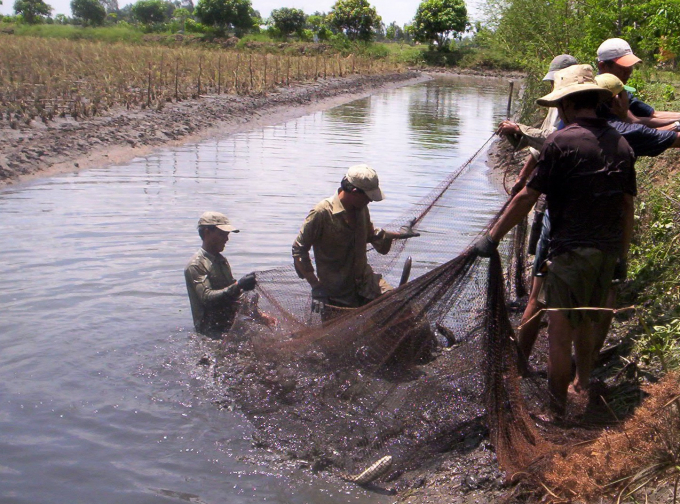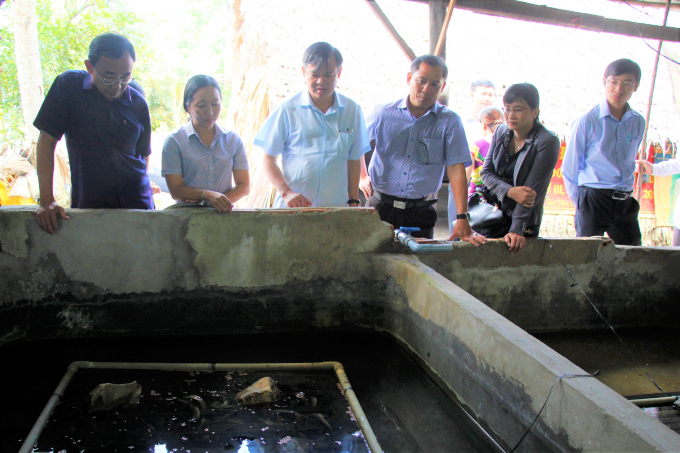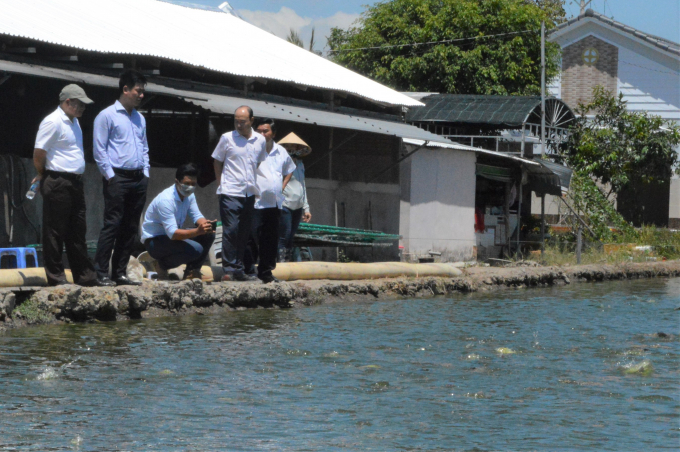November 27, 2025 | 21:24 GMT +7
November 27, 2025 | 21:24 GMT +7
Hotline: 0913.378.918
November 27, 2025 | 21:24 GMT +7
Hotline: 0913.378.918
Currently, Mekong Seafood Connection Co., Ltd (belonging to Mekong Food Group) has great demand for production linkage and construction of raw material areas for export processing. Company director Hoang Van Duy, said that the unit requires items such as: giant freshwater prawns, pangasius, frogs (frog legs), tilapia, persimmons, and dried products... with the quantity of about 1,500 tons per month. Additionally, other products are also being promoted for trade such as eel, sliced fish, sea fish...
Therefore, the unit wishes that the Department of Agriculture and Rural Development of localities in the Mekong Delta connect with cooperatives and aquaculture households to build a stable and sustainable raw material area. Especially connecting the local main, signature product lines.

Harvesting field fish raised in rice fields in Hau Giang
According to Mr. Duy, the Mekong Company will facilitate the linkage for cooperatives and individual farming households without experience in exporting goods. However, units need to coordinate and build production plans to meet the long-term needs of customers, especially in terms of output and quality. Producing relatively large quantities at competitive and mostly unchanged prices during order fulfillment.
Priority will be given to cooperatives and business households capable of providing preliminary products such as shelling (for shrimp), cleaning, gutting or filleting (for red tilapia, tilapia, eel), extracting thighs (for frogs), processing them into fish cakes, shrimp cakes...
The quality of raw materials must meet each requirement of the consumer market, such as: standards on microbiology, antibiotics in products, fishing certificates for marine fish if exported to the US, Europe...

Eel farming currently developing strongly in Hau Giang
In Hau Giang, many aquatic products such as pangasius, perch, snakehead, bronze featherback, farmed eel… have an output of up to tens of thousands tons per year. Nguyen Thi Giang, Deputy Director of Hau Giang Department of Agriculture and Rural Development, said that the complicated situation of the Covid-19 pandemic halted the food supply chain for export as well as for domestic consumption. The selling prices for some fresh commercial seafood products such as pangasius, bronze featherback, perch, snakehead fish, eel, etc. have all dropped.
However, because it is yet the main fishery harvest season, coupled with difficulties in trading, transporting and the decreasing selling price, farmers tend to produce in moderation (reduce the amount of feed) to wait for higher prices before selling. Hau Giang province invites businesses to visit the locality to study and sign contracts for long-term cooperation. Based on that, the agricultural sector will direct production, arrange suitable seasons and material areas. At the same time, support cooperatives to produce according to the criteria of the businesses' order, ensuring sustainable supply of raw materials.

Intensive cultivation of bronze featherbacks in Hau Giang gives high economic efficiency
According to Dr. Tran Minh Hai, Director of the Center for Cooperative Development (CCD - under the University of Agriculture and Rural Development Managers II), in order to create chain links, localities need to reorganize their production, support cooperatives to not only develop farming for products, but also to invest in preliminary processing to meet the order needs of businesses.
Mekong Seafood Connection Co., Ltd. needs the support of localities, suppliers and cooperatives with information, images and videos about products, product stories, farmers' and cooperatives stories. Certificates of quality, geographical indications, regional specialties are also needed... From there, the company's communications department will further promote the image of product chains from the locality to international customers.
Mr. Tran Dinh Luan, Director General of the Directorate of Fisheries (Ministry of Agriculture and Rural Development), emphasized that, in order to create linkage and cooperate in seafood consumption in the market export chain, localities must first organize production, create a material area large enough to meet the needs of businesses. Particularly, farmers and farming establishments prioritize quality standards. It is necessary to organize production according to cooperatives and apply VietGAP standards to ensure the quality of raw materials. In the long run, farming areas will be coded according to regulations.
Translated by Nguyen Hai Long

(VAN) According to Mr. Vo Minh Thanh, Director of the Tay Ninh Department of Agriculture and Environment, Resolution 57 has created a new development pathway for the locality, shifting from traditional toward modern agriculture.
/2025/11/26/4909-2-154329_878.jpg)
(VAN) Pearl grouper farming in HDPE cages not only delivers economic efficiency but also contributes to protecting the environment, creating jobs, and promoting marine-based experiential tourism.

(VAN) The model of making a living under the forest canopy through the agroforestry system in Van Son commune, Bac Ninh province, is expected to generate an annual income of approximately VND 30 million/ha.

(VAN) Many enterprises in Can Tho are harnessing natural energy and reducing greenhouse gas emissions in their production processes, thereby contributing to the promotion of a sustainable green transition.
/2025/11/24/3536-2-112800_176.jpg)
(VAN) Dong Nai now has tens of thousands of hectares of forests certified for sustainable management, and this area will continue to be expanded in the coming period.

(VAN) Vinh Ha hamlet (Dai Xuyen commune, Hanoi) is shifting away from small-scale farming as households adopt bioscurity into their breeder chicken models.

(VAN) Heavy rains make aquatic species more vulnerable to disease. Proactive water management and high-tech systems help farmers prevent outbreaks and protect yields.